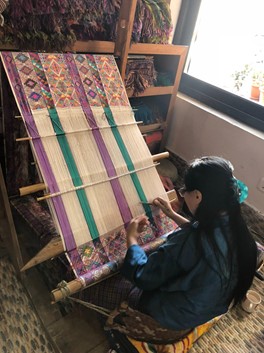How does structure give your life freedom? How do you balance chaos and order?
During a meditation trip to Bhutan, I couldn’t help but notice the conflict and coordination that exists between chaos and order.
When I was younger, I thought that order and chaos were diametrically opposite. But, as I have grown, I’ve learned the beautiful integration of order and chaos and how they can come together to form harmony and happiness. While structure gives you the freedom to operate, when a certain amount of chaos is thrown in the mix, it devolves into creativity.
When I was younger, my mom (of blessed memory) often faced chaos in her life. For instance, she’d cook a delicious dinner, only to find chaos in the kitchen: dirty dishes, used utensils, and melting butter left on the counter for days. My mom’s driving was terrible, and, as a result of this, she got in many, many accidents. I also remember my mom’s ubiquitous knitting bags. Even though she was creating beautiful works of craftsmanship, I’d constantly find yarn and knitting needles at every turn. In spite of the seaming chaos, my time with my mom was always full of love.

I lived my early life attempting to create a stable and structured framework so as to foster a sense of order. I knew that too much freedom can lead to chaos, but if it exists within a structured framework, it can lead to harmony. In an attempt to mitigate the inevitable chaos of life, I have tried to create a structure through which freedom can operate and harmony can emerge.
On my trip to Bhutan, I watched a Bhutanese woman weave the tapestry shown in this photo, and what I instantly noticed was the existence of a framework.
Each tapestry begins the same — simple straights and empty space full of opportunity. Straights and crosses. The plain white string strung top to bottom. On a loom, the straights make up the entirety of the structure.
Then, little by little, step by step, the crosses come together to create content. The beautiful colors of the thread weave across the straight to reveal a pattern.
Straights function as structure.
Crosses create the interest.
If a tapestry were made up of only straights, it would provide no interest. It would remain boring, plain, and simple.
If a tapestry were made up of only crosses, its beauty would be ephemeral and devoid of structure. Therefore, it would fall apart.
It was this epiphany that helped me recognize appreciate the harmony of chaos and order. When Chaos and order clash, chaos wins. When woven together, however, harmony emerges. A tapestry, such as the one shown above, can transport you, like a magic carpet, to a new time or place. The collaboration between the crosses and straights creates a beautiful representation of creativity.
In Judaism, there is a mystical tradition which discusses how chaotic energies can be woven together in a way that is productive, creative, and generative, rather than destructive. This concept is even alluded to at the very beginning of the Torah, when in Genesis 1 the creation of the universe is described as having come from chaos (“tohu” / תוֹהוּ). Order (also known as “tikkun”/ תִּקּוּן in Kabbalah) then appears once light is created when God first declares: “Let there be light.” Upon this proclamation, order and chaos come together in a harmonious bond.
Just as order and chaos fused together to create the universe, the same process occurs, on a much smaller scale, in our own minds. In Hebrew, the verb to think (chashav) is derived from the root of “to weave.” Thus, in the biblical imagination, “thinking” is synonymous with “weaving.” When we devote time to thoughtful reflections, we allow ourselves to weave together the chaos and order of everyday life.
May you find the appropriate levels of chaos and order, create the balance necessary for freedom, and experience the joy of harmony.






